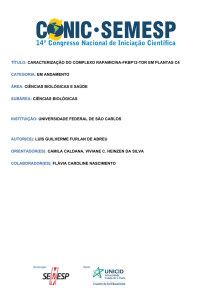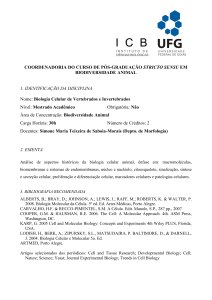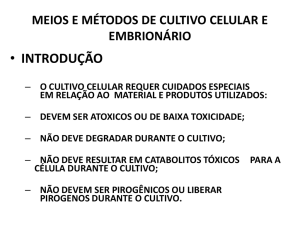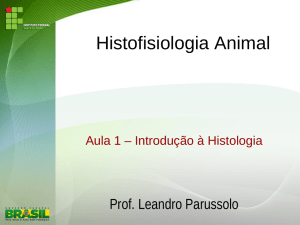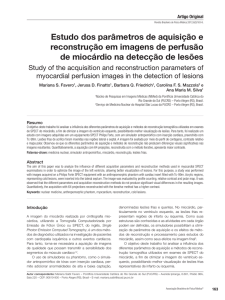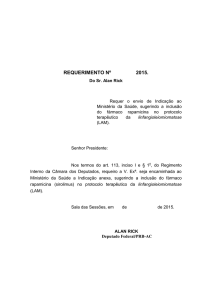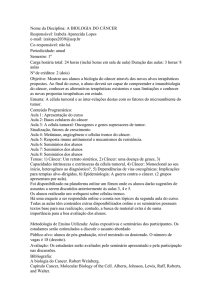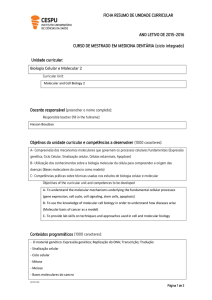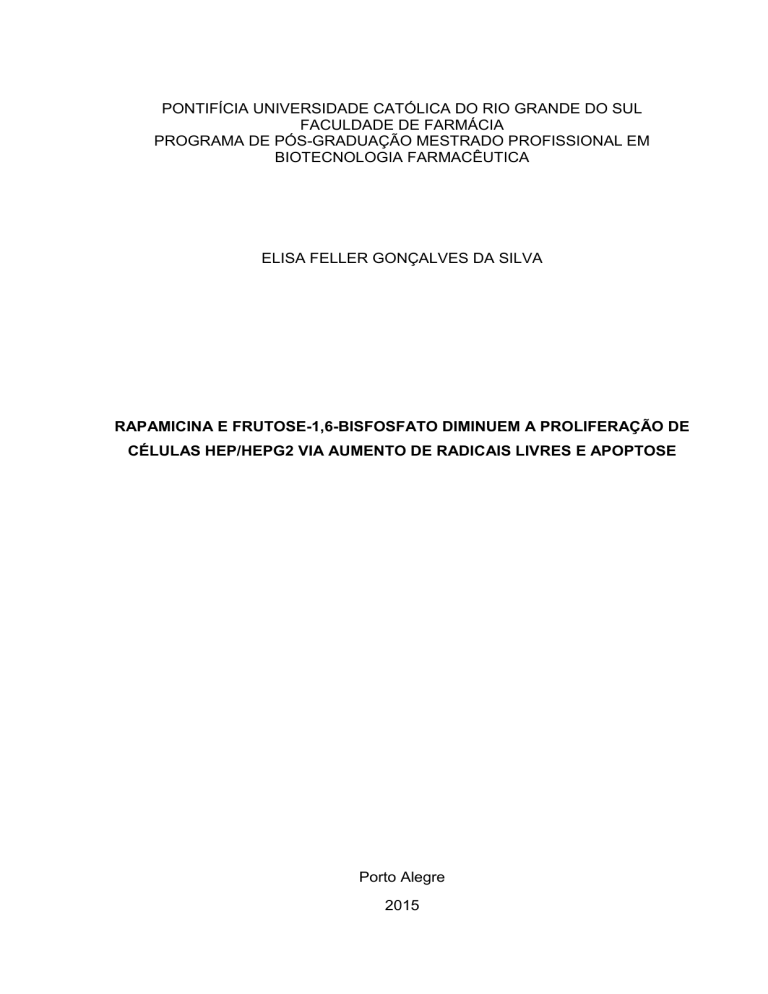
PONTIFÍCIA UNIVERSIDADE CATÓLICA DO RIO GRANDE DO SUL
FACULDADE DE FARMÁCIA
PROGRAMA DE PÓS-GRADUAÇÃO MESTRADO PROFISSIONAL EM
BIOTECNOLOGIA FARMACÊUTICA
ELISA FELLER GONÇALVES DA SILVA
RAPAMICINA E FRUTOSE-1,6-BISFOSFATO DIMINUEM A PROLIFERAÇÃO DE
CÉLULAS HEP/HEPG2 VIA AUMENTO DE RADICAIS LIVRES E APOPTOSE
Porto Alegre
2015
ELISA FELLER GONÇALVES DA SILVA
RAPAMICINA E FRUTOSE-1,6-BISFOSFATO DIMINUEM A PROLIFERAÇÃO DE
CÉLULAS HEP/HEPG2 VIA AUMENTO DE RADICAIS LIVRES E APOPTOSE
Dissertação apresentada como requisito
parcial para obtenção do grau de Mestre
pelo Programa de Pós-Graduação Stricto
Sensu
Mestrado
Profissional
em
Biotecnologia Farmacêutica da Faculdade de
Farmácia da Pontifícia Universidade Católica
do Rio Grande do Sul.
Orientador: Prof. Dr. Jarbas Rodrigues de Oliveira
Co-orientador: Profa. Dra. Fernanda Bordignon Nunes
Porto Alegre
2015
“Só existem dois dias no ano que
nada pode ser feito. Um se chama
ontem e o outro se chama amanhã,
portanto hoje é o dia certo para amar,
acreditar, fazer e principalmente
viver.”
Dalai Lama
RESUMO
O carcinoma hepatocelular é o tipo de tumor mais prevalente entre os
tumores primários que atingem o fígado. Seu desenvolvimento está geralmente
relacionado a uma doença hepática crônica, a qual pode ser originada por uma
infecção viral (hepatite B e C), alcoolismo, cirrose criptogênica, doenças biliares e
hemocromatose primária. A rapamicina, um agente imunossupressor, é atualmente
utilizada como base na quimioterapia no tratamento de diversos tipos de câncer,
inclusive nos hepáticos. Por apresentar diversos efeitos adversos graves nos
pacientes em tratamento, inclusive nefrotoxicidade, é evidente a importância de
minimizar estes efeitos sem comprometimento da eficácia, neste sentido outras
drogas podem ser utilizadas concomitantemente. Uma destas drogas é a frutose1,6-bisfosfato (FBP) que tem demonstrado efeito terapêutico em várias situações
patológicas. Também foram documentados efeitos benéficos da FBP em
deficiências orgânicas, renais e hepáticas. O objetivo deste trabalho foi avaliar a
atividade da rapamicina em conjunto com a FBP na proliferação celular, estresse
oxidativo e processo inflamatório de células HepG2, analisando os efeitos
citotóxicos, na tentativa de minimizar os efeitos adversos e aumentar a eficácia e
segurança para os pacientes em tratamento. Os resultados demonstraram que a
combinação de rapamicina e FBP é mais eficiente do que no uso isolado das
mesmas, pois doses subterapêuticas de rapamicina, quando associadas à FBP,
tornaram-se eficazes, não sendo esta inibição da proliferação celular ocasionada por
necrose. Em 72h de tratamento, não foram observadas alterações na rota
inflamatória ou na autofagia das células, porém a combinação rapamicina e FBP
aumentou significativamente a produção das substâncias reativas ao ácido
tiobarbitúrico (TBARS) e a apoptose celular, processo que pode inibir a proliferação
do tumor. Estes resultados demonstram que esta associação pode ser uma escolha
promissora para o tratamento de hepatocarcinoma.
Palavras-chave: Rapamicina. Frutose-1,6-bisfosfato. Células HepG2. Carcinoma
Hepatocelular. Radicais livres. Apoptose.
ABSTRACT
Hepatocellular carcinoma is the most prevalent type of tumor among primary
tumors affecting the liver. Its development is usually related to a chronic liver
disease, which can be caused by a viral infection (hepatitis B and C), alcoholism,
cryptogenic cirrhosis, biliary disease and primary hemochromatosis. Rapamycin, an
immunosuppressant agent, is currently used as the basis of chemotherapy in the
treatment of various cancers, including the liver. By presenting several serious
adverse effects in patients undergoing treatment, including nephrotoxicity, it is clear
the importance of minimizing these effects without compromising efficacy. In this
sense, other drugs may be used concomitantly. One of these drugs is fructose-1,6bisphosphate (FBP), which has shown therapeutic effect in various pathological
situations. Beneficial effects of FBP in organic, liver and kidney deficiencies were
also documented. The objective of this study was to evaluate the activity of
rapamycin in combination with the FBP in cell proliferation, oxidative stress and
inflammation of hepatocellular carcinoma HepG2 cells, analyzing the cytotoxic effects
in an attempt to minimize adverse effects and increase the efficacy and safety for
patients undergoing treatment. The results demonstrated that the combination of
rapamycin and FBP is more efficient than the single use of them, because
subtherapeutic doses of rapamycin, when associated to FBP become effective, and
this inibition in cell proliferation is not caused by necrosis. In 72 hours of treatment,
there was no change in the inflammatory route or in autophagy of cells, but the
combination of rapamycin and FBP significantly increased the production of
Thiobarbituric acid reactive substances (TBARS) and the cellular apoptosis, a
process that can inhibit tumor proliferation. These results demonstrate that this
association may be a promising choice for hepatocarcinoma treatment.
Keywords: Rapamycin. Fructose-1,6-bisphosphate. HepG2 Cells. Hepatocellular
Carcinoma. Free radicals. Apoptosis.
LISTA DE ABREVIATURAS
FBP – Frutose-1,6-bisfosfato
HCC – Carcinoma Hepatocelular
HCV – Vírus da Hepatite C
ATCC - American Type Culture Collection
EROS - Espécies reativas de oxigênio
ERN - Espécies reativas de nitrogênio
COX -2 - Ciclooxigenase 2
IL-4 – Interleucina 4
IL-6 – Interleucina 6
IL-10 – Interleucina 10
TNF-α – Fator de necrose tumoral alfa
PGE-2 – Prostaglandina E2
DANEs - Drogas antiinflamatórias não esteroidais
ATP- Adenosina trifosfato
O2 - Oxigênio
NADP – Nicotinamida adenina dinucleotídeo fosfato
mTOR - alvo da rapamicina em mamíferos
SUMÁRIO
1 INTRODUÇÃO..........................................................................................................7
1.1 Hepatocarcinoma...................................................................................................7
1.2 Células de hepatocarcinoma – HEPG2.................................................................7
1.3 Inflamação e câncer...............................................................................................8
1.4 Terapias antineoplásicas convencionais................................................................9
1.5 Inovações na terapia antineoplásica......................................................................9
1.6 Rapamicina...........................................................................................................11
1.7 Frutose-1,6-bisfosfato (FBP)................................................................................12
2 JUSTIFICATIVA......................................................................................................14
3 OBJETIVOS............................................................................................................15
3.1 Objetivo geral.......................................................................................................15
3.2 Objetivos específicos............................................................................................15
4 ARTIGO CIENTÍFICO.............................................................................................16
5 CONSIDERAÇÕES FINAIS....................................................................................38
6 REFERÊNCIAS.......................................................................................................40
7 ANEXO....................................................................................................................43
7
1 INTRODUÇÃO
1.1 Hepatocarcinoma
Os tumores malignos do fígado podem ser divididos em dois tipos: primários
(que tem origem no próprio órgão) e secundários ou metastáticos (originados em
outros órgãos). Dentre os tumores originados no fígado, o hepatocarcinoma, ou
carcinoma hepatocelular, é o mais frequente1.
O carcinoma hepatocelular (HCC), está entre as principais doenças no mundo
atualmente, sendo o quinto tumor maligno mais freqüente, representando 85% dos
tumores hepáticos primários e é responsável por quase dois terços da morte entre
os cânceres. O prognóstico geralmente é ruim, devido ao rápido crescimento tumoral
e a ausência de sintomas no inicio da doença2; 3.
O desenvolvimento da maioria dos hepatocarcinomas relaciona-se com
complicações decorrentes de quadros de cirrose (caracterizada pela fibrose
progressiva e a reorganização da microarquitetura vascular). A presença de algumas
doenças de base, como a hepatite B e C, são uma das principais causas do tumor 4.
Outro fator de risco para o hepatocarcinoma é a ingestão de grãos ou cereais
contaminados com Aspergillus flavus, que produz a substância cancerígena
aflatoxina1.
O HCC está entre as dez principais neoplasias que afetam a população
mundial. Sua incidência tem aumentado nos últimos anos, principalmente pela
infecção do vírus da Hepatite C (HCV). O aumento da incidência gera aumento de
custos com a saúde, demonstrando a necessidade de desenvolvimento de terapias
mais acessíveis5.
1.2 Células de hepatocarcinoma – HEPG2
HepG2, é uma linhagem de células do fígado provenientes de um
hepatoblastoma humano, é utilizada como modelo de tumores de células hepáticas,
visto que mantêm funções metabólicas semelhantes aos hepatócitos 6.
8
Segundo dados do protocolo da linhagem celular HepG2, comercializada pela
American Type Culture Collection (ATCC), a linhagem é derivada de carcinoma
hepatocelular, apresenta morfologia epitelial, crescimento aderente e não é
tumorigênica em camundongos imunossuprimidos. Por tanto, essa linhagem é
utilizada apenas em estudos “in vitro”, não sendo recomendado para estudos “in
vivo” com o objetivo de desenvolver tumores em animais7.
1.3 Inflamação e Câncer
Estudos recentes mostram que há uma íntima relação entre inflamação e
câncer. Evidências epidemiológicas e experimentais suportam o conceito que o
processo inflamatório crônico promove o desenvolvimento e proliferação dos
tumores. Há uma forte associação entre inflamação crônica de um órgão em
particular e um específico câncer para este órgão. Esta associação envolve o fator
tempo, ou seja, quanto mais tempo esta inflamação persiste maior será o risco de
desenvolver uma neoplasia8.
Mediadores inflamatórios, como por exemplo, as citocinas, os radicais livres,
prostaglandinas e fatores de crescimento podem induzir a alterações na homeostase
celular, resultando no desenvolvimento e progressão do câncer. Vários mecanismos
inflamatórios estão envolvidos no câncer. Um dos mais importantes é a instabilidade
genômica causada pela inflamação. A ativação de leucócitos, principalmente
macrófagos e granulócitos, leva à síntese de espécies reativas de oxigênio (EROS)
e nitrogênio (ERN) que podem provocar dano ao DNA, proteínas e lipídeos, podendo
gerar mutações nas células. As lesões por radicais livres podem ser causadas por
uma enzima pró-inflamatória, a ciclooxigenase 2 (COX-2), que leva a produção de
altos níveis de peróxidos no interior das células8; 9.
Além da produção aumentada dos radicais livres pelo processo inflamatório,
outras situações podem alterar o meio celular e promover câncer:
a.
O aumento de citocinas inflamatórias pode aumentar o sinal
proliferativo, que por sua vez pode potencialmente aumentar o número de células
com risco de sofrerem mutação;
b.
Produtos da inflamação podem alterar eventos celulares e provocar
expressão gênica inapropriada;
9
c.
Diminuição em substâncias supressoras de tumor e de células T
regulatórias que podem contribuir para o efeito antitumoral da célula.
Além desses fatores, recentemente se descobriu que tumores provocados por
células-tronco mostram estrita relação com citocinas inflamatórias. A interleucina 6
(IL-6) possui um papel preponderante no câncer de mama por sustentar a sobrevida
e a capacidade proliferativa das células-tronco. Além disso, estudos preliminares
mostraram que níveis elevados de IL-6 estão associados a uma alta taxa de
expressão de metástases e mau prognóstico no HCC. Também foi evidenciado o
papel da interleucina 4 (IL-4), no desenvolvimento do câncer de cólon9; 10.
1.4 Terapias Antineoplásicas Convencionais
Dentre os vários tipos de terapias contra o câncer, as terapias tradicionais são
a ressecção cirúrgica, a radioterapia e a quimioterapia, sendo esta última a
modalidade mais amplamente empregada. As terapias podem ser utilizadas
isoladamente ou em associação8. Apesar das distintas opções de tratamento, a
terapia do câncer apresenta grande dificuldade de manejo, principalmente devido à
baixa especificidade de alguns fármacos e a estreita janela terapêutica, as quais
estão intimamente relacionadas à toxicidade. Dessa forma a busca pelo
desenvolvimento de novas terapias mais específicas torna-se necessária11.
O tratamento do HCC varia de acordo com o estágio em que o tumor se
encontra, assim como em outros tipos de câncer. No estágio inicial, no qual o tumor
está localizado somente no fígado e não há metástases, a cirurgia de ressecção do
tumor é geralmente recomendada. Em alguns casos, o transplante de fígado pode
ser indicado, sendo essas duas opções terapêuticas (ressecção cirúrgica e
transplante) as únicas consideradas atualmente como curativas. Outras terapias têm
sido utilizadas de forma paliativa, como embolização, ablação por radiofrequência
(destruição das células tumorais por calor ou frio) e injeção com etanol5.
1.5 Inovações na Terapia Antineoplásica
A Imunoprevenção e a imunoterapia pertencem a um novo campo de estudos
contra o câncer. Por haver uma correlação estrita entre câncer e inflamação,
terapias que diminuem a inflamação antes da imunização podem aumentar a
eficácia da imunoterapia.
10
A ciclooxigenase 2 (COX-2) é uma isoforma de COX que catalisa a etapa
chave do metabolismo do ácido araquidônico e a produção de prostaglandinas. As
prostaglandinas, notadamente a PGE-2, podem aumentar a produção de tumores.
Uma elevação da COX-2 é frequentemente citada em uma variedade de tumores
localizados em células epiteliais de estroma.
Estudos
em
humanos
e
em
animais
têm
mostrado
que
drogas
antiinflamatórias não esteroidais (DANEs) são quimioprotetoras para o câncer de
cólon e adenoma. Drogas que seletivamente inibem a COX-2, incluindo DANEs,
estão sendo usadas em estudos para tratamento de câncer. Estudos recentes estão
determinando o efeito de inibidores da COX-2 sobre o desenvolvimento de câncer
de mama e câncer colorretal. Também tem sido observado que pessoas que fazem
uso corrente de DANEs têm baixo risco de desenvolverem câncer. Outras drogas
que tem como base a inibição da COX-2 reduziram significativamente a progressão
de melanoma em camundongos12.
Apesar de não haver evidências em estudos de imunização, antagonistas do
fator de necrose tumoral alfa (TNF-α) representam uma boa opção para potencializar
vacinas contra o câncer. Antagonistas TNF (etanercept, infliximab, adalimumab) que
foram licenciados para estudos epidemiológicos para Artrite Reumatóide e Doença
de Crohn têm demonstrado várias ações que podem ser úteis para terapia contra o
câncer, porque eles podem diminuir a produção de citocinas, reduzir a angiogênese,
prevenir a infiltração de leucócitos e melhorar as funções da medula óssea.
Atualmente, muitos inibidores da produção de TNF-α têm sido usados no tratamento
do câncer, incluindo numerosos produtos originados de frutas, vegetais e de plantas
medicinais, que são testados em modelos de câncer. Entre os produtos naturais que
podem ter impacto na imunização contra o câncer, destaca-se a vitamina E, que
possui dois mecanismos distintos: efeito direto sobre as células e ação indireta,
através de suas propriedades antiinflamatórias, principalmente relacionada com
redução da produção de PGE-213; 14.
Outra inovação nas terapias anticâncer é inibição da via mTOR (alvo da
rapamicina em mamíferos), que tem demonstrado suprimir o crescimento de tumores
hepáticos e a formação de metástases15; 16. Apesar desses resultados animadores, o
HCC frequentemente demonstra posterior resistência à rapamicina quando utilizada
11
isoladamente. Dessa forma, novos estudos têm pesquisado a associação da
rapamicina com outras drogas antitumorais para diminuir ou evitar a resistência
terapêutica17; 18.
1.6 Rapamicina:
A rapamicina, uma lactona macrocíclica produzida pelo Streptomyces
hygroscopicus, de fórmula molecular C51 H79 NO13 e peso molecular de 914,2,
é um quimioterápico altamente eficaz, tendo como mecanismo de ação a inibição da
mTORC1 Desde sua aprovação pela US Food and Drug Administration, em 1999, a
rapamicina, foi administrada em vários pacientes que receberam transplante de rim
devido a sua atividade imunossupressora. Na década de 80, cientistas também
descobriram que a droga inibe o crescimento de tumores e, desde 2007, dois
derivados dela: o Temsirolimus da Pfizer e o Everolimus da Novartis foram
aprovados contra vários tipos de câncer, inclusive o de fígado, administrado
isoladamente ou em combinação com outras drogas19.
O mecanismo de ação da rapamicina ocorre intracelularmente, onde esses
inibidores formam um complexo com a proteína 12 ligada a FK506 (FKBP-12) que é
reconhecida pelo alvo da rapamicina em mamíferos (mTOR). A formação do
complexo resulta na inibição da atividade do mTOR e da expressão da proteína
S6K, como consequência haverá inibição da progressão do ciclo celular, sobrevida e
angiogênese (Figura 1)20; 21; 22.
Evidências clínicas e experimentais mostram forte correlação entre a
dosagem e eficácia. Os efeitos secundários induzidos por rapamicina como náusea,
vômito, anemia, hiperlipidemia, toxicidade respiratória, cardio, e nefrotoxicidade são
dependentes da dose e limitam a administração de dosagens mais altas,
comprometendo assim a eficácia terapêutica. Sendo a nefrotoxicidade uma das
principais limitações, o monitoramento da função renal torna-se obrigatório durante o
tratamento19; 20.
Isto torna as doses inadequadas o obstáculo mais significativo na definição
exata do papel clínico da rapamicina, e, provavelmente, na expansão da sua
atividade. Portanto, quando altas doses de rapamicina são administradas, é
essencial identificar drogas eficazes de suporte que podem impedir ou contrariar os
12
efeitos secundários sérios da rapamicina. Uma delas é a frutose-1,6-bisfosfato
(FBP), um açúcar que possui mecanismos que promovem proteção renal 23.
Figura 1- Mecanismo da rapamicina
Fonte: http://www.bioss.uni-freiburg.de/ 22
1.7 Frutose-1,6-bisfosfato (FBP)
A frutose-1,6-bisfosfato (FBP) é um dos metabólitos encontrados na rota
glicolítica, apresentando estruturas estáveis anoméricas: α e β furanose. Este açúcar
bisfosforilado, além de ser um subproduto da via glicolítica também exerce papel
importante junto a diversas rotas metabólicas do organismo. Entre suas ações
regulatórias aparece a sua capacidade de alterar o metabolismo de carboidratos
estimulando a glicólise e inibindo a gliconeogênese23.
A FBP tem demonstrado efeitos terapêuticos em várias situações patológicas
como: isquemia, choque e lesões tóxicas. Também foram documentados os efeitos
13
benéficos de FBP em deficiências orgânicas cardíacas, renais, cerebrais, intestinais
e hepáticas24; 25.
Os mecanismos pelos quais a FBP protege células e tecidos ainda não são
claros. Um possível mecanismo de proteção inclui o metabolismo anaeróbio da FBP
para gerar adenosina trifosfato (ATP)26 ou reduzir a sua perda27, e/ou pela sua
propriedade quelante de cálcio28. Esta capacidade da FBP em diminuir a quantidade
de cálcio extracelular, melhora o rendimento mecânico e respiratório do coração
isquêmico25, sendo este mediado pela ativação de fosfoquinase-C, que modula a
atividade intracelular do cálcio29. Este açúcar também aumenta a captação celular
de potássio, que resulta em uma diminuição intracelular da concentração de sódio,
reduzindo assim, o edema celular citotóxico30.
Além disto, o aumento dos níveis de ATP pela FBP pode reduzir a formação
de O2, tendo em vista de que este pode ser o regulador fisiológico da atividade
catalítica da enzima nicotinamida adenina dinucleotídeo fosfato (NADP) oxidase,
uma das enzimas responsáveis pela produção destes radicais. A FBP inibe a
formação de espécies reativas de oxigênio e a ativação de neutrófilos, reduz a
proliferação e a viabilidade de linfócitos T e também inibe a apoptose em
hepatócitos24; 26; 31; 32.
A fim de evidenciar um destes mecanismos de proteção, o estudo de
Azambuja et al, utilizou a FBP em conjunto a cisplatina, um quimioterápico de
estreita janela terapêutica, com nefrotoxicidade similar à rapamicina. Esta
associação diminuiu significativamente os níveis de creatinina e uréia em
comparação com o grupo de cisplatina. Além disso, a necrose tubular aguda
também foi menos severa nos animais que receberam cisplatina com FBP do que
nos animais que receberam apenas cisplatina. Este fato demonstrou que a FBP tem
um efeito protetor sobre a função e parênquima renais em ratos de que tiveram
nefrotoxicidade induzida pela cisplatina. O efeito anti-inflamatório da frutose-1,6bisfosfato confirma o seu efeito protetor em casos de lesão celular31.
14
2 JUSTIFICATIVA
O difícil manejo da resistência de células neoplásicas, alta toxicidade e
consequentes
efeitos
desenvolvimento
de
adversos
novas
têm
terapias
impulsionado
as
antineoplásicas.
pesquisas
Os
para
tratamentos
o
do
hepatocarcinoma são em sua maioria paliativos, exceto a ressecção cirúrgica e o
transplante (terapias curativas); porém ainda com possibilidade de recidiva. Dessa
maneira, a busca de novas alternativas terapêuticas para a doença torna-se um
campo de pesquisa em expansão. Dentre os tratamentos, a rapamicina está sendo
largamente utilizada, porém as altas doses utilizadas nas quimioterapias atualmente
provocam vários efeitos secundários, principalmente nefrotoxicidade. Na tentativa de
utilizar subdoses da rapamicina, sem comprometimento da eficácia, a usaremos em
combinação com a FBP. Este açúcar vem demonstrando propriedades terapêuticas
antioxidantes e antinflamatórias além de um efeito nefroprotetor em diversos estudos
envolvendo modelos animais. Sabendo que o processo de carcinogênese envolve
mediadores inflamatórios como citocinas, quimiocinas, espécies reativas de
oxigênio, acreditamos que a FBP possa ser útil na manutenção do efeito terapêutico
da rapamicina e inibição dos eventos de adversos.
15
3 OBJETIVOS
3.1 Geral
Avaliar o efeito da rapamicina isolada e em conjunto com a frutose-1,6bisfosfato sobre a proliferação, parâmetros inflamatórios e estresse oxidativo em
células de carcinoma hepático (HepG2).
3.2 Específicos
Verificar se dose subterapêutica da rapamicina em conjunto com a FBP
mantêm o efeito na inibição do crescimento celular da linhagem celular
HepG2;
Avaliar marcadores para apoptose (DAPI) e autofagia (Laranja de
Acridina);
Verificar se a ação da combinação de rapamicina e frutose-1,6bisfosfato pode alterar a síntese de citocinas inflamatórias e antiinflamatórias nas culturas celulares;
Avaliar a influência da associação da rapamicina e frutose-1,6bisfosfato sobre estresse oxidativo em células HepG2.
16
4 ARTIGO CIENTÍFICO
Os resultados do presente trabalho foram submetidos ao periódico Cell
Proliferation (fator de impacto: 3.28).
17
Rapamycin and fructose-1,6-bisphosphate reduce the HEP / HEPG2 cell
proliferation via increase of free radicals and apoptosis
Running head: Action of rapamycin and FBP in HepG2 cells
Elisa Feller Gonçalves da Silva1, Gabriele Catyana Krause1, Gabriela Viegas Haute1,
Kelly Goulart Lima1, Fernanda Cristina Mesquita1, Leonardo Pedrazza1, Bruno Souza
Basso1, Anderson Catarina Velasquez1, Fernanda Bordignon Nunes1, Jarbas
Rodrigues de Oliveira*
1
Laboratory of Cellular Biophysics and Inflammation, Department of Cellular and
Molecular Biology, Pontifícia Universidade Católica do Rio Grande do Sul (PUCRS).
Abstract: 208 words
Maintext: 3898 words
* To whom correspondences should be addressed at Laboratório de Pesquisa em
Biofísica Celular e Inflamação, Pontifícia Universidade Católica do Rio Grande do
Sul (PUCRS), Avenida Ipiranga 6681, prédio 12, bloco C, sala 221, CEP 90619-900,
Porto Alegre, Rio Grande do Sul, Brazil. E-mail: [email protected]
18
ABSTRACT
Background: Hepatocellular carcinoma is the most prevalent type of tumor among
primary tumors affecting the liver. Rapamycin is currently used as a basis for
chemotherapy in the treatment of cancers, including the liver. Because it shows
several adverse effects, it is clear the importance of minimizing these effects without
compromising efficacy. In this sense other drugs may be used concomitantly. One of
these drugs is fructose-1,6-bisphosphate (FBP), which has shown therapeutic effect
in various pathological situations, having antioxidants and anti-inflammatory
proprieties. The objective of this study was to evaluate the activity of rapamycin in
combination with the FBP in HepG2 cell proliferation and others mechanisms
involved. Methods: HepG2 cells were analyzed after 72 hours of treatment with both
drugs. Cell proliferation, cytotoxicity, cytokines, apoptosis, senescence, autophagy
and oxidative stress were accessed. Results: Was demonstrated that the
combination is more efficient than the single use of substances, because
subtherapeutic doses of rapamycin, when associated to FBP become effective,
reducing cell proliferation, through a significant increase in the production of
Tiobarbituric Acid Reactive Substances (TBARS), suggesting that this might be the
cause of death by apoptosis. Conclusions: According to these results, we believe that
the association of both drugs may be a promising choice for the treatment of
hepatocarcinoma.
Keywords: Rapamycin. Fructose-1,6-bisphosphate. HepG2 Cells. Hepatocellular
Carcinoma. Free radicals. Apoptosis.
19
INTRODUCTION
Hepatocellular carcinoma (HCC), is among the leading diseases in the world
today, being the fifth most common malignant tumor, representing 85% of primary
liver tumors and accounts for nearly two thirds of death among cancers. The
prognosis is generally poor due to rapid tumor growth and the absence of symptoms
at the beginning of disease1; 2.
The chronic inflammatory state appears to be necessary for the initiation and
development of liver cancer and the HCC is an example of inflammation-related
cancer3; 4. The presence of some underlying disease, such as hepatitis B and C, is a
major cause the tumor5. HCC is among the top ten cancers that affect the world
population. Its incidence has increased in recent years, mainly by infection of
hepatitis C virus6.
Among the various types of cancer therapies, appeared the surgical resection,
radiotherapy and chemotherapy, the latter being the most widely used mode.
Therapies may be used singly or in combination3. Even with different options,
treatment against cancer has difficulty handling, mainly due to the low specificity of
some drugs and the narrow therapeutic window, which are closely related to the
toxicity. Thus, the search for the development of new therapies becomes extremely
necessary7. A recent innovation in the anticancer therapy is inhibition of the mTOR
(mammalian target of rapamycin), which has been shown to suppress the growth of
liver tumors and metastasis8; 9. These results are encouraging, but the HCC often
shows higher resistance to rapamycin when used alone. Thus, new studies have
investigated the association of rapamycin with other antitumor drugs to reduce or
avoid treatment resistance10; 11.
Rapamycin, a macrocyclic lactone produced by Streptomyces hygroscopicus,
molecular formula C51 H79 NO13 and molecular weight 914.2, is a highly effective
chemotherapy, with the mechanism of action inhibition of mTORC1. Since its
approval by the US Food and Drug Administration in 1999, rapamycin was
administered in several patients who received kidney transplant due to its
immunosuppressive activity. In the 80s, scientists also found that the drug inhibits the
growth of tumors and, since 2007, two derivatives of it: the Temsirolimus (Pfizer) and
Everolimus (Novartis) were approved against various cancers, including liver,
administered alone or in combination with other drugs12.
20
The mechanism of action of rapamycin occurs intracellularly where these
inhibitors form a complex with the protein bound to FK506 12 (FKBP-12) that is
recognized by mTOR. The formation of the complex results in inhibition of the activity
of mTOR and S6K expression of the protein, will result in inhibition of cell cycle
progression, survival and angiogenesis13; 14.
Clinical and experimental evidences show strong correlation between dosage
and toxicity. The rapamycin induced side effects such as nausea, vomiting, anemia,
hyperlipidemia, respiratory toxicity, cardiovascular, and nephrotoxicity are dosedependent and limited administration of higher dosages, thus compromising
therapeutic efficacy. The nephrotoxicity is one of the major limitations, for this reason,
the monitoring of the renal function becomes required during treatment15;
16
. This
makes inadequate doses the most significant obstacle in the exact definition of the
clinical role of rapamycin, and probably in expanding its activity. Therefore, when
high doses are administered rapamycin is essential to identify effective drug carrier
that can prevent or counteract the side effects of rapamycin15. One of them is the
fructose-1,6-bisphosphate (FBP), a sugar which has mechanisms that promote renal
protection17.
Previous studies reported the antioxidant and anti-inflammatory therapeutic
properties plus a nephroprotecting effect in animal models of FBP. Knowing that the
process of carcinogenesis involves inflammatory mediators such as cytokines,
chemokines, reactive oxygen species, we believe that the FBP can be helpful in
maintaining the therapeutic effect of rapamycin and inhibition of adverse effects.
Therefore, the aim of this study was to evaluate the effect of rapamycin alone and in
combination with fructose-1,6-bisphosphate on cell death and proliferation,
inflammation and oxidative stress parameters in liver carcinoma cells (HepG2).
21
MATERIALS AND METHODS
Cell Culture
Human hepatocarcinoma cell line (HepG2) was obtained from the American
Type Culture Collection (ATCC). The medium used for the culture of cells was
Dulbecco's Modified Eagle Medium (DMEM) supplemented with fetal bovine serum
(FBS 10%) under a humidified atmosphere containing 5% CO2. HepG2 cells after
being cultured and present approximately 70% confluence were detached from
culture bottles and transferred to 96-well culture plates at a uniform cell density.
Treatment with rapamycin and fructose-1,6-bisphosphate
The plates were incubated at 37 ° C in a humidified incubator with 5% CO2 at
72 hours treatment time with rapamycin (Wyeth Pharmaceuticals Co., USA), tested in
different concentrations of 10, 20, 30, 40 and 50 nM 18;
19
and fructose 1,6
bisphosphate (Sigma Chemical Co., USA) at doses of 5 and 10 mM, and in the
DMEM medium in order to perform a curve correlating doses cell growth and
proliferation. The FBP concentrations were in agreement with experiments performed
in our laboratory on HepG2 cells and rapamycin on impact articles.
Evaluation of cellular proliferation
The assessment of the viability and cellular growth/proliferation was performed
by cell counting in a Neubauer chamber. The experiments were performed in
triplicate and repeated three times. After this evaluation the rapamycin doses of 10
nM and 10 mM FBP were selected.
Measurement of lactate dehydrogenase (LDH)
Cytotoxicity was assessed by the presence of the enzyme lactate
dehydrogenase (LDH) in the supernatant of cell cultures using the UV kinetic method
(Lactate-Pyruvate) using Labtest Diagnostic Kit SA.
The test LDH (lactate dehydrogenase) is a marker of membrane integrity. The
enzyme lactate dehydrogenase is present throughout the cell cytoplasm, and when
the membrane is damaged there is released to the external environment. The LDH
allows to analyze the number of total inviable (dead) cells20.
22
Quantification of cytokines
To determine the production of cytokines, the treated HepG2 cells were
incubated for 72 hours, supernatants were collected and stored at -20 ° C for later
analysis. Pro and anti-inflammatory cytokines were simultaneously measured by flow
cytometry using Human Inflammatory Cytokine Kit - BD Biosciences.
Evaluation of Apoptosis, Senescence and Autophagy
HepG2 cells were treated in 24-well plates for a preview of apoptosis,
senescence and autophagy. Apoptosis and senescence were evaluated by DAPI (4',
6-diamidino-2-phenylindole), a fluorescent staining that binds strongly to regions rich
in adenine and thymine in DNA sequences21. The evaluation of was autophagy by
Acridine Orange (AO), a vital acidotropic fluorescent dye22. The results were
visualized by fluorescent inverted microscope and the apoptotic and senescent nuclei
were quantified using Image-Pro Plus software.
Evaluation of Oxidative Stress
Oxidative stress of liver carcinoma cells was measured by the method of
thiobarbituric acid (TBARS) by fluorimetry.
Statistical Analysis
The results were presented using descriptive statistics (mean and standard
deviation). For the comparison of means between groups analysis of variance
(ANOVA) and post hoc Tukey Test for multiple comparisons were used. In the
presence of asymmetry was used the corresponding nonparametric. The level of
significance will be p <0.05 with a 95% confidence interval and the data were
analyzed by the SPSS (Statistical Package for Social Sciences) for Windows, version
15.0. (SPSS Inc. Ohio, USA).
23
RESULTS
The evaluation of cell proliferation of rapamycin (R) at concentrations of 10,
20, 30, 40 and 50 nM, FBP 5 and 10 mM and the association of the two substances
was performed. In figure 1, it is observed that rapamycin (R) causes a significant
decrease in concentrations of 40 and 50 nM and the FBP causes a reduction of cell
growth at concentrations of 5 and 10 mM. In figure 2, it is evident that the association
with FBP 10 mM makes effective the subtherapeutic doses of 10, 20 and 30 nM of
rapamycin (R). Already in combination with 5 nM of FBP, rapamycin (R) did not
decrease cell proliferation in any of the concentrations. For this reason, the doses of
10 mM FBP and 10 nM rapamycin (R) were selected for the following experiments.
The integrity of the membrane of HepG2 cells treated with rapamycin (R) and
FBP, isolated and in combination, was evaluated through the measurement of LDH in
the cell culture supernatant. There was a decrease in the percentage of LDH
released when we join rapamycin (R) and FBP, demonstrating that there is a
significant decrease in cell death associated with necrosis in this group in
comparison to the others. For other parameters differences were not seen in relation
to the control group (Figure 3).
Inflammation and cancer are associated, for this reason we evaluated the proinflammatory and anti-inflammatory cytokines. We selected the Tumor necrosis factor
alpha, TNF-α (Figure 4A) and the Interleukin 10, IL-10 (Figure 4B). The ratio between
the cytokines was also done (Figure 4C). Was not observe changes of cytokines in
relation to the control, and the ratio gave the balance between pro- and antiinflammatory.
To see if the decreased of cellular proliferation was by apoptosis or
senescence, DAPI staining was used. The figure 5A presents a picture of normal
nuclei, in 5B, the apoptotic nuclei can by visualized and in figure 5C the senescent
nuclei are represented. In the analyses of normal nuclei, rapamycin (R) and FBP had
a significantly decreased (Figure 5D), while in figure E is demonstrated a significant
increase of apoptotic nuclei percentage in the association of rapamycin (R) and FBP.
In senescent nuclei analyses, rapamycin(R) and FBP isolated increased significantly
in relation to the association group and the control group.
24
The autophagy, another cellular death mechanism that involves cell
degradation of unnecessary or dysfunctional components 23, was analyzed in HepG2
cells through the use of Acridine Orange dye. No significant differences were funded
between the studies groups (Figure 6A, 6B, 6C and 6D).
The oxidative stress can provoke cellular damage, for this reason, we
analyzed Thiobarbituric acid reactive substances (TBARS)24. Our results showed an
antioxidant effect of FBP, but in association to rapamycin (R), provoke a significant
increase in the release of free radicals in relation to the other groups (Figure 7).
25
DISCUSSION
The HCC is closely linked with chronic inflammation. This association involves
the time factor, the longer the inflammation persists, the greater is risk of developing
cancer 25.
Rapamycin, a known immunosuppressant used in kidney transplant patients,
also acts by inhibiting the complex of the mammalian target of rapamycin, mTOR.
Also
known
as
FKBP12-rapamycin
associated
protein
(FRAP),
mTOR
is
26
a serine/threonine protein kinase that promotes cell proliferation and differentiation ,
therefore, rapamycin is currently being used to treat certain types of cancer 27.
However, its use is limited due to its toxicity and resistance to prolonged use that
cause adverse events, mainly nephrotoxicity28. For this reason, the association with
other substances in order to avoid adverse events becomes essential. The FBP, a
sugar belonging to glycolytic cellular route that has some therapeutic effects in
inflammatory diseases, such as rheumatoid arthritis and septisemia29, was chosen
for the combination with rapamycin
Our first results showed that rapamycin and FBP singly decreases the
proliferation of HepG2 cells, however when they were used in combination,
rapamycin was effective at lower doses, suggesting a decrease in therapeutic
dosage. This effect may have been caused by necrosis (cytotoxicity), apoptosis,
autophagy, or senescence. For this, first, with the intention of proving that this
association has no cytotoxicity, we done the measure of LDH that did not
demonstrated correlation between the stop in cell proliferation and death due to
necrosis. Also, we saw a significant increase in the preservation of cell membrane
when we compared control and isolated drugs groups. These results demonstrate
that the combination of substances decreased the cellular toxicity of rapamycin.
Inflammatory mediators, such as cytokines, free radicals, and growth factors
prostalandinas can induce changes in cellular homeostasis, leading to the
development and progression of cancer. Several inflammatory mechanisms are
involved in cancer. One of the most important is the genomic instability caused by
inflammation.
The
activation
of
leukocytes,
especially
macrophages
and
granulocytes, leads to the synthesis of reactive oxygen species (ROS) and nitrogen
(RNS) that can cause damage to DNA, proteins and lipids, which may cause
26
mutations in the cells. The free radical damage can be caused by a proinflammatory
enzyme, cyclooxygenase 2 (COX-2), which leads to production of high levels of
peroxides within the cells. Therefore, therapies that reduce inflammation prior to
immunization can increase the efficacy of immunotherapy30; 31.
In the last two decades, emerged evidence that the molecular level of most
chronic diseases, including cancer, are caused by a dysregulated inflammatory
response. The Tumor necrosis factor α (TNF- α) exerts regulatory role, by stimulating
the biosynthesis of growth factors. It is directly cytotoxic to endothelial cells and can
induce the biosynthesis of collagenases, proteases, reactive oxygen intermediates
and arachidonic acid metabolites. In other hand, interleukins with multifaceted antiinflammatory properties, like interleukin-10 (IL-10), including inhibition of the
prototypic inflammatory transcription factor nuclear factor kappa B, leading to
suppressed cytokine production, reduction of tissue factor expression, inhibition of
apoptosis of macrophages and monocytes after infection32.
To check if the decreased of cellular proliferation is occurring by the
inflammatory rote, we analyzed pro-inflammatory cytokines TNF-α and antiinflammatory IL-10, besides the ratio there between. None of parameters show
changes in relation to the control and the ratio demonstrated the inflammatory
balance between cytokines.
Apoptosis, a programmed cell death, is decreased in cancer cells. Many
therapies try to increase apoptosis of these in order to reduce their proliferation 18.
Another way of cell death that is also reduced in cancer is senesce. Senescence is
the aging of the cell that occurs when they stop dividing to replace other cells that, for
some reason, failed to metabolize. On the other hand, cancer cells have an enzyme
called telomerase that regenerates telomeres of the cell, allowing it to multiply
indefinitely33.
It then emerged, through the use of the fluorescent staining DAPI and
quantification of the images generated by fluorescent inverted microscope, which did
increase significantly the apoptosis in the association of rapamycin and FBP doses.
Also, there was a significant increase in senescence of nuclei in the rapamycin and
FBP isolated compared to the control group. By comparing the results of cell
proliferation of the isolated drugs is concluded that, in spite of being a potential
27
anticancer factor, senescence did not seem to influence the decrease in cell
proliferation.
The autophagy, a mechanism that may protect against cancer by isolating
damaged organelles, allowing cell differentiation, increasing and promoting cell death
of cancerous cells23, was analyzed through the use of Acridine Orange staining. No
difference was seen in autophagy between and the control and the treated groups.
The cytoperoxidation is a cell membrane damage caused by free radicals.
This toxic effect can be assessed by the formation of Thiobarbituric acid reactive
substances (TBARS), especially malondialdehyde (MDA)24. Our results showed that,
while FBP singly decreases the cytoperoxidation, the combination of the two drugs
cause a significant injury provoked by free radicals, suggesting that this phenomenon
might be the cause of cell death by apoptosis.
This study promotes for the first time the combination of these two drugs and
addresses the importance of trying the combination of substances such as FBP, with
other drugs commonly used to treat cancer such as rapamycin to a more effective
result and the promotion of quality of life for patients in treatment.
28
CONCLUSION
From this study it is concluded that the concomitant use of rapamycin and FBP
could be a promising treatment for patients with hepatocellular carcinoma, because
the combination of rapamycin with fructose significantly reduces cell proliferation and
most importantly, brings to reality the possibility of achieving the goal of making an
effective subtherapeutic dose, minimizing the serious known reactions to drugs used
in cancer therapy today by the increased of free radicals and apoptosis when the
association is used.
29
BIBLIOGRAPHIC REFERENCES
1 ORGANIZATION, W. H. The top 10 causes of death. Geneva - Switzerland
(2012).
http://www.who.int/mediacentre/factsheets/fs310/en/index.html.
Accessed 14 april 2015.
2 Gonzalez SA (2014). Novel biomarkers for hepatocellular carcinoma
surveillance: has the future arrived? Hepatobiliary Surg Nutr. 6:410-4. doi:
10.3978/j.issn.2304-3881.2014.07.06.
3 Baird A, Lee J, Podvin S et al (2014). Esophageal cancer-related gene 4 at
the interface of injury, inflammation, infection, and malignancy.
Gastrointest Cancer 4:131-142.
4 Capece D, Fischietti M, Versela D et al (2013). The Inflammatory
Microenvironment in Hepatocellular Carcinoma: A Pivotal Role for TumorAssociated
Macrophages.
Biomed
Res
Int. 2013:187204.
doi:
10.1155/2013/187204.
5 Bharadwaj S, Gohel TD (2015). Perspectives of physicians regarding
screening patients at risk of hepatocellular carcinoma. Gastroenterol Rep
(Oxf). pii: gou089.
6 Salhab M, Canelo R (2011). An overview of evidence-based management of
hepatocellular carcinoma: a meta-analysis. J Cancer Res Ther 4:463-75. doi:
10.4103/0973-1482.92023.
7 Almeida J R C D (2004). Farmacêuticos em Oncologia: uma nova realidade.
São Paulo, pp 358.
8 Wang Z, Zhou J, Fan J et al (2009). Sirolimus inhibits the growth and
metastatic progression of hepatocellular carcinoma. J Cancer Res Clin Oncol,
5:715-22. doi: 10.1007/s00432-008-0506-z.
9 Wang Z, Zhou J, Fan J et al (2008). Effect of rapamycin alone and in
combination with sorafenib in an orthotopic model of human hepatocellular
carcinoma. Clin Cancer Res 16:5124-30. doi: 10.1158/1078-0432.
10 Wang C, Gao D, Guo K et al (2012). Novel synergistic antitumor effects of
rapamycin with bortezomib on hepatocellular carcinoma cells and orthotopic
tumor model. BMC Cancer 12:166. doi: 10.1186/1471-2407-12-166.
11 Wang Y, Speeg KV, Washburn WK, Halff G (2010). Sirolimus plus sorafenib in
treating HCC recurrence after liver transplantation: a case report. World J
Gastroenterol 43:5518-22.
12 U.S. Food and Drug Administration. 203985 Everolimus Clinpharm
BPCA/22088
Temsirolimus
Clinpharm
BPCA.
http://www.fda.gov/Drugs/default.htmhtml. Accessed 14 april 2015.
13 Porta C, Paglino C, Mosca A (2014). Targeting PI3K/Akt/mTOR Signaling in
Cancer. Front Oncol 4:64. doi: 10.3389/fonc.2014.00064.
30
14 Sahin F, Kannangai R, Adegbola O, Wang J, Su G, Torbenson M (2004).
mTOR and P70 S6 kinase expression in primary liver neoplasms. Clin Cancer
Res. 24:8421-5.
15 Cuconati A, Mills C, Goddard C et al (2013). Supression of AKT anti-apoptotic
signaling by a novel drug candidate results in grown arrest and apoptosis of
hepatocellular
carcinoma
cells.
PLoS
One. 1:e54595.
doi:
10.1371/journal.pone.0054595.
16 Cendales L, Bray R, Gebel H et al (2015). Tacrolimus to Belatacept
Conversion Following Hand Transplantation: A Case Report. Mar 13. doi:
10.1111/ajt.13217.
17 Seok SM, Park TY, Park HS, Baik EJ, Lee SH (2015). Fructose-1,6bisphosphate suppresses lipopolysaccharide-induced expression of ICAM-1
through modulation of toll-like receptor-4 signaling in brain endothelial cells. Int
Immunopharmacol. 1:203-211. doi: 10.1016/j.intimp.2015.03.029.
18 Zhang JF, Liu JJ, Lu MQ, Cai CJ, Yang Y, Li H, Xu C, Chen GH (2007).
Rapamycin inhibits cell growth by induction of apoptosis on hepatocellular
carcinoma cells in vitro. Transpl Immunol. Apr;17(3):162-8.
19 Dai ZJ, Gao J, Ma XB et al (2012). Antitumor effects of rapamycin in
pancreatic cancer cells by inducing apoptosis and autophagy. Int J Mol
Sci.1:273-85. doi: 10.3390/ijms14010273.
20 Philipp AB, Nagel D, Stieber P at al (2014). Circulating cell-free methylated
DNA and lactate dehydrogenase release in colorectal cancer. BMC Cancer.
14:245. doi: 10.1186/1471-2407-14-245.
21 Kim TM, Shin SK, Kim TW, Youm SY, Kim DJ, Ahn B (2012). Elm tree bark
extract inhibits HepG2 hepatic cancer cell growth via pro-apoptotic activity. J
Vet Sci. 1:7-13.
22 Eduardo
C.
F.
Chiela.
Protocol
for
measuring
autophagy.
http://www.ufrgs.br/labsinal/autofagia.htm. Accessed: 22 april 2015.
23 Nepal S, Park PH (2014). Regulatory role of autophagy in globular
adiponection-induced apoptosis in cancer cells. Biomol Ther (Seoul). 5:3849. doi: 10.4062/biomolther.2014.021.
24 Carlos
SP,
Dias AS,
Forgiarini Junior LA,
et al
(2014).
Oxidative damage induced by cigarette smoke exposure in mice: impact on lu
ng tissue and diaphragm muscle. J Bras Pneumol. 4:411-20.
25 Rutkowski MR, Conejo-Garcia JR (2015). Size does not matter: commensal
microorganisms forge tumor-promoting inflammation and anti-tumor immunity.
Oncoscience. 3:239-46.
26 Asnaghi
L, Bruno
P, Priulla M, Nicolin
A
(2004).
mTOR: a
protein kinase switching between life and death. Pharmacol Res. 6:545-9.
27 McGranahan N, Favero F, de Bruin EC, Birkbak NJ, Szallasi Z, Swanton C
(2015). Clonal status of actionable driver events and the timing of mutational
31
processes in cancer evolution.
10.1126/scitranslmed.aaa1408.
Sci
Transl
Med. 283:283ra54.
doi:
28 Fervenza FC, Fitzpatrick PM, Mertz J, et al (2004). Acute rapamycin
nephrotoxicity in native kidneys of patients with chronic glomerulopathies.
Nephrol Dial Transplant. 5:1288-92.
29 Azambuja AA, Lunardelli A, Nunes FB et al (2011). Effect of fructose-1,6biphosphate on nefrotoxicity induced by cysplatin in rats. Inflammation. 1:6771. doi: 10.1007/s10753-010-9212-5.
30 Seelaender M, Neto JC, Pimentel GD, Goldszmid RS, Lira FS (2015).
Inflammation in the disease: mechanism and therapies 2014. Mediators
Inflamm. 2015:169852. doi: 10.1155/2015/169852.
31 Raza H, John A, Benedict S (2011). Acetylsalicylic acid-induced oxidative
stress, cell cycle arrest, apoptosis and mitochondrial dysfunction in human
hepatoma
HepG2
cells.
Eur
J
Pharmacol.
1-2:15-24.
doi:
10.1016/j.ejphar.2011.06.016.
32 Goswami B, Rajappa M, Mallika V, Shukla DK, Kumar S (2009). TNF-alpha/IL10 ratio and C-reactive protein as markers of the inflammatory response in
CAD-prone North Indianpatients with acute myocardial infarction. Clin Chim
Acta.1-2:14-8.
33 Raouf S, Weston C, Yucel N (2015). Registered report: senescence
surveillance of pre-malignant hepatocytes limits liver cancer development.
Elife 26;4. doi: 10.7554/eLife.04105.
32
FIGURES
Figure 1:
Figure 2:
33
Figure 3:
Figure 4:
34
Figure 5:
35
Figure 6:
Figure 7:
36
FIGURE LEGENDS
Fig. 1. The isolated effect of rapamycin (R) and fructose-1,6-bisphosphate (FBP) on
HepG2 cells proliferation. Cells were treated with R (10-50nM) and FBP (5 and
10mM) for 72 h and cell viability assessed by direct cell count. Data represent the
mean ± SD. Results were expressed as cell number. (**p<0,05, ***p<0,001 vs
control).
Fig. 2. The association effect of rapamycin (R) and fructose-1,6-bisphosphate (FBP)
on HepG2 cells proliferation. Cells were treated with the combination of R (10-50nM)
and FBP (5 and 10mM) for 72 h and cell viability assessed by direct cell count. Data
represent the mean ± SD. Results were expressed as cell number. (***p<0,001 vs
control).
Fig. 3. Percent of release of lactate dehydrogenase of HepG2 cells after treatment
with rapamycin (R) 10nM, fructose-1,6-bisphosphate (FBP) 10mM and rapamycin (R)
+ fructose-1,6-bisphosphate (FBP) 10mM. Results are expressed as mean data
represent the mean ± SD. Results of the association were *p<0,05 vs control and
#p<0,05 vs R and FBP.
Fig. 4. Flow cytometric analyses of TNFα (A), IL-10 (B) and TNFα/IL-10- Ratio in cell
supernatant (C) of HepG2 cells after 72h of treatment with rapamycin (R) 10nM,
fructose-1,6-bisphosphate
(FBP) 10mM and
rapamycin
(R) +
fructose-1,6-
bisphosphate (FBP) 10mM. Data represented the mean ± SD. Cytokines levels were
expressed as picograms per 1000 cells.
Fig. 5. Effects of rapamycin (R) 10nM, fructose-1,6-bisphosphate (FBP) 10mM and
rapamycin (R) + fructose-1,6-bisphosphate (FBP) 10mM in HepG2 cell nuclei were
visualized through images obtained by fluorescent inverted microscope. The figure A
37
presents normal nuclei, B apoptotic nuclei and C senescent nuclei. Figure D: Percent
of normal nuclei. Results are expressed as mean data represent the mean ± SD.
Results were expressed as cell number. (**p<0,05, ***p<0,001 vs control). Figure E:
Percent of apoptotic nuclei. Results are expressed as mean data represent the mean
± SD. Results were expressed as cell number. (***p<0,001 vs control). Figure F:
Percent of senescent nuclei. Results are expressed as mean data represent the
mean ± SD. Results were expressed as cell number. (***p<0,001 vs control).
Fig. 6. Effect of rapamycin (R) 10nM, fructose-1,6-bisphosphate (FBP) 10mM and
rapamycin (R) + fructose-1,6-bisphosphate (FBP) 10mM on the autophagy of HepG2
cells. Images were obtained by fluorescent inverted microscope. Control (A), R (B),
FBP (C) and R+FBP (D).
Fig. 7. Effect of rapamycin (R) 10nM, fructose-1,6-bisphosphate (FBP) 10mM and
rapamycin (R) + fructose-1,6-bisphosphate (FBP) 10mM on oxidative stress
measured by TBARS. Data represent as mean ± SD (*p<0.05 and ***p<0,001 vs
control).
38
5 CONSIDERAÇÕES FINAIS
Considerando a diminuição da proliferação em células HepG2 demonstrada
no uso de subdoses da rapamicina em combinação com a FBP, sugere-se uma
diminuição na dosagem terapêutica. Esta associação não apresentou citotoxicidade
e a parada na proliferação não teve correlação com a morte celular por necrose.
Além disso, observamos um aumento significativo na preservação da membrana
celular quando comparamos o grupo controle aos grupos das drogas isoladas. Estes
resultados demonstram que a combinação de rapamicina e FBP diminuiu a
toxicidade celular de rapamicina.
Os mediadores inflamatórios tais como as citocinas, radicais livres, e fatores
de crescimento prostaglandinas podem induzir alterações na homeostase celular,
conduzindo ao desenvolvimento e progressão do câncer8; 9. Por isto também
analisamos a rota inflamatória através da citocina pró-inflamatórias TNF-α e a antiinflamatória IL-10, além da razão entre as mesmas, verificamos que não há
influencia destas citocinas no decréscimo da proliferação celular.
A apoptose, uma morte celular programada, é diminuída em células
cancerosas. Muitas terapias tentar aumentar a apoptose destes, a fim de reduzir a
sua proliferação32. Outra forma de morte celular que também é reduzida em câncer é
a senescência. A senescência é o envelhecimento da célula que ocorre quando elas
param de se dividir para substituir outras células que, por algum motivo, não
conseguiram metabolizar. Por outro lado, as células cancerígenas têm uma enzima
telomerase que regenera os telômeros da célula, permitindo-lhe multiplicar
indefinidamente33.
Verificou-se então, por meio da utilização de coloração fluorescente DAPI, que a
apoptose aumentou significativamente na associação de rapamicina e FBP. Além
disso, houve um aumento significativo da senescência dos núcleos em FBP a
rapamicina e isolado em comparação com o grupo de controle. Ao verificar os
resultados da proliferação celular das substâncias isolados conclui-se que, apesar
de ser um fator potencial anticancerígeno, a senescência não pareceu influenciar na
diminuição da proliferação de células.
39
A autofagia, um mecanismo de morte da célula que pode ser protetor contra o
câncer34, foi analisada através da utilização de coloração com Laranja de Acridina.
Não foi visualizada diferença significativa entre os tratamentos e o grupo controle.
A citoperoxidação é um dano da membrana celular causada por radicais
livres. Este efeito tóxico pode ser avaliado através da formação de substâncias
reativas ao ácido tiobarbitúrico (TBARS), especialmente o malondialdeído (MDA)
34
.
Os nossos resultados mostraram que, ao passo que a FBP isoladamente diminui a
citoperoxidação, a combinação das duas drogas causou uma lesão significativa
provocada por radicais livres, o que sugere que este fenómeno pode ser a causa de
morte celular por apoptose.
Este estudo promove pela primeira vez, a combinação das duas drogas que
demonstra a importância da tentativa de combinação de substâncias, tais como
FBP, com outros medicamentos comumente utilizados no tratamento de câncer, tais
como a rapamicina, para obtenção de um resultado mais eficaz e de uma melhora
da qualidade de vida para pacientes em tratamento.
40
REFERÊNCIAS
1 INCA. Câncer de Fígado. Rio de Janeiro, 2015. Disponível em: <
http://www2.inca.gov.br/wps/wcm/connect/tiposdecancer/site/home/figado >.
Acesso em: 14/01/2015.
2 ORGANIZATION, W. H. The top 10 causes of death. Genebra - Suíça, 2012.
Disponível
em:
<
http://www.who.int/mediacentre/factsheets/fs310/en/index.html >. Acesso em:
14/01/2015.
3 Gonzalez SA. Novel biomarkers for hepatocellular carcinoma surveillance: has
the future arrived? Hepatobiliary Surg Nutr. 2014 Dec;3(6):410-4.
4 Bharadwaj S, Gohel TD. Perspectives of physicians regarding screening
patients at risk of hepatocellular carcinoma. Gastroenterol Rep (Oxf). 2015
Jan 5.
5 Salhab M, Canelo R. An overview of evidence-based management of
hepatocellular carcinoma: a meta-analysis. J Cancer Res Ther, v. 7, n. 4, p.
463-75, 2011 Oct-Dec 2011. ISSN 1998-4138.
6 Tyakht AV et al. RNA-Seq gene expression profiling of HepG2 cells: the
influence of experimental factors and comparison with liver tissue. BMC
Genomics. 2014 Dec 15;15(1):1108.
7 (ATCC), A. T. C. C. Product Information Sheet for ATCC HB-8065. Manassas
-USA 2012.
8 Baird A et al. Esophageal cancer-related gene 4 at the interface of
injury, inflammation,
infection,
and
malignancy.
Gastrointest Cancer. 2014;2014(4):131-142.
9 Raza H, John A, Benedict S. Acetylsalicylic acid-induced oxidative stress, cell
cycle arrest, apoptosis and mitochondrial dysfunction in human hepatoma
HepG2 cells. Eur J Pharmacol, v. 668, n. 1-2, p. 15-24, Oct 2011.
10 Shi L, Feng Y, Lin H, Ma R, Cai X. Role of estrogen in hepatocellular
carcinoma: is inflammation the key? J Transl Med. 2014 Apr 8;12:93.
11 ALMEIDA, J. R. C. D. Farmacêuticos em Oncologia: uma nova realidade. 1.
São Paulo: 2004. 358
12 Contractor N et al. Cutting edge: Peyer's patch plasmacytoid dendritic cells
(pDCs) produce low levels of type I interferons: possible role for IL-10,
TGFbeta, and prostaglandin E2 in conditioning a unique mucosal pDC
phenotype. J Immunol, v. 179, n. 5, p. 2690-4, Sep 2007.
13 Fan He et al. Antitumor effects of dammarane-type saponins from steamed
Notoginseng. Pharmacogn Mag. 2014 Jul-Sep; 10(39): 314–317.
41
14 Cao J, Yang X, Li WT, Zhao CL, Lv SJ. Silencing of COX-2 by RNAi
Modulates Epithelial-Mesenchymal Transition in Breast Cancer Cells Partially
Dependent
on
the PGE2 Cascade.
Asian
Pac
J Cancer Prev. 2014;15(22):9967-72.
15 Wang, Z. et al. Sirolimus inhibits the growth and metastatic progression of
hepatocellular carcinoma. J Cancer Res Clin Oncol, v. 135, n. 5, p. 715-22,
May 2009. ISSN 1432-1335.
16 Wang, Z. et al. Effect of rapamycin alone and in combination with sorafenib in
an orthotopic model of human hepatocellular carcinoma. Clin Cancer Res, v.
14, n. 16, p. 5124-30, Aug 2008. ISSN 1078-0432.
17 WANG, C. et al. Novel synergistic antitumor effects of rapamycin with
bortezomib on hepatocellular carcinoma cells and orthotopic tumor model.
BMC Cancer, v. 12, p. 166, 2012. ISSN 1471-2407.
18 WANG, Y. et al. Sirolimus plus sorafenib in treating HCC recurrence after liver
transplantation: a case report. World J Gastroenterol, v. 16, n. 43, p. 5518-22,
Nov 2010. ISSN 2219-2840.
19 U.S. Food and Drug Administration. 203985 Everolimus Clinpharm
BPCA/22088 Temsirolimus Clinpharm BPCA.
Disponível em: <
http://www.fda.gov/Drugs/default.htmhtml>. Acesso: 14/01/2015.
20 Yubao W et al. Sirolimus plus sorafenib in treating HCC recurrence after liver
transplantation: A case report. World J Gastroenterol. Nov 21, 2010; 16(43):
5518–5522.
21 mTOR and rapamycin in the kidney: signaling and therapeutic implications
beyond immunosuppression. Disponível em: < http://www.bioss.unifreiburg.de/cms/1245.html >. Acesso em: 14/01/2015.
22 Kirtley ME, McKay M. Fructose-1,6-bisphosphate, a regulator of metabolism.
Mol Cell Biochem. 1977 Dec 29;18(2-3):141-9.
23 Calafell R, Boada J et al. Fructose 1,6-bisphosphate reduced TNF-alphainduced apoptosis in galactosamine sensitized rat hepatocytes through
activation of nitric oxide and cGMP production. Eur J Pharmacol. 2009 May
21;610(1-3):128-33.
24 De Oliveira JR, Rosa JL, Ambrosio S, Bartrons R. Effect of galactosamine on
hepatic carbohydrate metabolism: protective role of fructose 1,6-bisphosphate.
Hepatology. 1992 Jun;15(6):1147-53.
25 Nunes FB, Graziottin CM, Alves Filho JC, Lunardelli A, Pires MG, Wachter PH
et al. An assessment of fructose-1,6-bisphosphate as an antimicrobial and
anti-inflammatory agent in sepsis. Pharmacol Res. 2003 Jan;47(1):35-41.
26 Gregory GA, Welsh FA, Yu AC, Chan PH. Fructose-1,6-bisphosphate reduces
ATP loss from hypoxic astrocytes. Brain Res. 1990 May 21;516(2):310-2.
42
27 Hassinen IE, Nuutinen EM, Ito K, Nioka S, Lazzarino G, Giardina B, et al.
Mechanism of the effect of exogenous fructose 1,6-bisphosphate on
myocardial energy metabolism. Circulation. 1991 Feb;83(2):584-93.
28 Donohoe PH, Fahlman CS, Bickler PE, Vexler ZS, Gregory GA.
Neuroprotection and intracellular Ca2+ modulation with fructose-1,6bisphosphate during in vitro hypoxia-ischemia involves phospholipase Cdependent signaling. Brain Res. 2001 Nov 2;917(2):158-66.
29 Santos RC, et al. Fructose-1,6-bisphosphate protects against Zymosaninduced acute lung injury in mice. Inflammation. 2012 Jun;35(3):1198-203.
30 Azambuja AA, et Al. Effect of fructose-1,6-biphosphate on nefrotoxicity
induced by cysplatin in rats. Inflammation. 2011 Feb;34(1):67-71.
31 Sola A, Panes J, Xaus C, Hotter G. Fructose-1,6-biphosphate and nucleoside
pool modifications prevent neutrophil accumulation in the reperfused intestine.
J Leukoc Biol. 2003 Jan;73(1):74-81.
32 Zhang JF, Liu JJ, Lu MQ, Cai CJ, Yang Y, Li H, Xu C, Chen GH.
Rapamycin inhibits cell growth by induction of apoptosis on hepatocellular
carcinoma cells in vitro. Transpl Immunol. 2007 Apr;17(3):162-8.
33 Raouf S, Weston C, Yucel N. Registered report: Senescence surveillance of
pre-malignant hepatocytes limits liver cancer development. Elife. 2015 Jan
26;4.
34 Nepal S, Park PH. Regulatory role of autophagy in globular adiponectininduced apoptosis in cancer cells. Biomol Ther (Seoul). 2014 Sep;22(5):3849.
43
7 ANEXO

